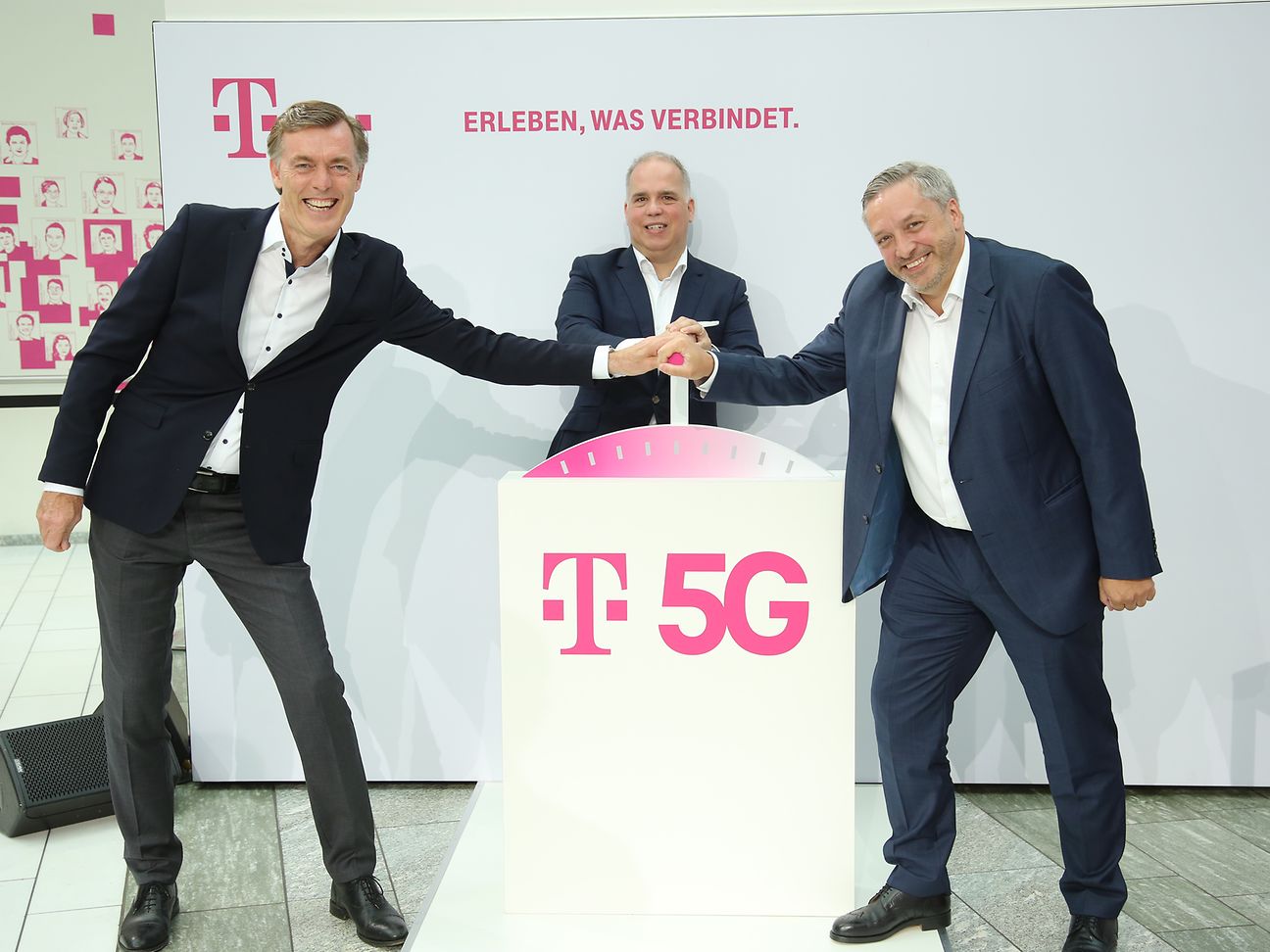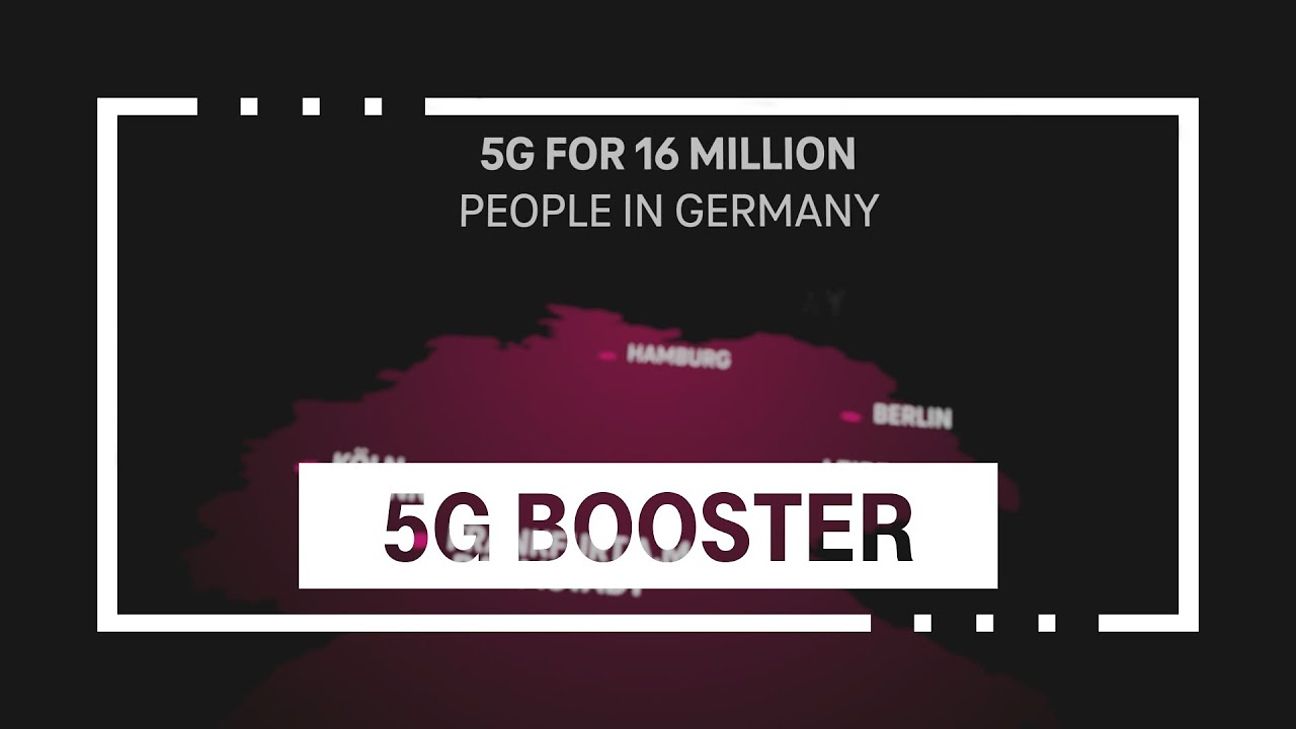

5G-Boost: 5G from today for over 16 million people in Germany
- Telekom in Germany has over 12,000 antennas for 5G in live operation
- 50 percent of the population will benefit from 5G by mid-July
- Telekom acquires 10 MHz of additional 3G spectrum ahead of schedule
- Even for LTE customers, more speed in the city and in the countryside
- Tariff and smartphone offers for easy 5G entry
As of today, over 16 million people in Germany can use the Telekom 5G network. The company now supplies more than 1,000 towns and communities completely or partly with the new mobile communications standard. From the beach at the North Sea to Cologne's Domplatte and the ice cream parlor on the countryside.
The expansion continues at full speed. By mid-July, as many as 40 million people throughout Germany will be benefiting from 5G. With innovative technology, intelligent use of spectrum, the right rates and new 5G smartphones, Deutsche Telekom is enabling its customers to enter the 5G age.
"This is the largest 5G initiative in Germany. We are bringing 5G to urban and rural areas for half of the German population. And we are now reaching this milestone earlier than planned," emphasizes Telekom Deutschland CEO Dirk Wössner. "Despite the Corona crisis, we have expanded 5G without detours. Our networks have worked reliably. In addition to the current situation, our technicians have made over 12,000 antennas fit for 5G. By the end of the year, there will even be 40,000 antennas fit for 5G. That is a huge achievement. Deutsche Telekom will also have the best network for 5G. In a first step, around 16 million people in Germany will be able to use 5G from today. By mid-July, half the population of Germany will be able to use it." Customers will not only be offered the best network, but also the right tariffs and attractive smartphones, Wössner said.
Telekom acquires 10 MHz of additional 3G spectrum ahead of schedule
The turbo in mobile communications roll-out is made possible by the variable use of mobile phone frequencies and new, innovative technologies. Deutsche Telekom uses 15 megahertz (MHz) in the 2.1 gigahertz band for LTE and 5G. Of this, 5 MHz come from the previous 3G spectrum and will be rededicated. In addition, Deutsche Telekom acquired 10 MHz of the current 3G spectrum from another provider ahead of schedule. It is also using this spectrum for LTE and 5G. Deutsche Telekom had originally purchased this spectrum for use from 2021, but by purchasing it ahead of schedule, the Group has tripled the spectrum previously used for the new technologies in this frequency range. Deutsche Telekom customers are thus already benefiting from significantly higher bandwidth for LTE and 5G.
Innovative technology meets intelligent use of spectrum
Deutsche Telekom uses the different frequencies in such a way that they complement each other in terms of range and speed. 5G generally works on a very high frequency in large cities: 3.6 GHz at Deutsche Telekom. High frequencies offer higher speeds. At the same time, these frequencies do not have a particularly long range. At the lower 2.1 GHz frequency, the ranges of 5G antennas are significantly higher. The principle is already familiar from LTE roll-out: Here, long-range frequencies are used primarily for wide area coverage. Frequencies with shorter ranges show their strengths in urban areas, ensuring a good coverage for a large number of customers with highspeed connection at the same time.
With this combination of available frequencies, Deutsche Telekom is significantly accelerating the roll-out of 5G - especially in rural areas. LTE will also receive a further boost from the technology push. Customers will receive an additional frequency band for using LTE and thus more bandwidth. The use of Dynamic Spectrum Sharing (DSS) will provide additional spectrum for LTE customers. As a result, they too will be able to surf even faster than before.
With DSS, Deutsche Telekom operates two mobile communications standards in parallel in one frequency band. The new technology distributes the spectrum between LTE and 5G users according to demand. The network automatically adapts to the needs of the respective customers within milliseconds. This leads to an even better user experience.
More speed in the countryside and in the city – also for LTE
DSS and the additional spectrum increase the data rate: In rural areas, speeds are sometimes more than doubled. Here, customers can now surf at up to 225 Mbit/s. In urban areas, peak speeds are 600-800 Mbit/s. Not only customers with the new 5G smartphones benefit from these speeds, but also customers in the LTE network. In large cities such as Berlin or Cologne, the 5G antennas transmit at 3.6 GHz with a data rate of up to 1 Gbit/s and more.
Integrated offers from the network, tariff and mobile phones
Telekom has the largest 5G network in Germany. More and more people are benefiting from this - including and especially private customers. Suitable 5G tariffs have been available for almost a year now: 5G is included in all MagentaMobil rates. Almost two million customers have booked the rate portfolio so far and can use 5G. A wide range of 5G-enabled end devices is also already available. For the new 2.1 GHz frequencies, devices from the Samsung S20 series, the OnePlus 8 and OnePlus 8 Pro as well as the Huawei P40 Pro are available. These smartphones already have the necessary software update or will soon receive it automatically. The device portfolio for 5G will be gradually expanded. All other 5G devices that Deutsche Telekom will introduce this year will incorporate the new technology. Most existing customers can also use LTE with their existing equipment and therefore benefit equally from DSS.
From July 1 to 27, Deutsche Telekom is offering all customers and those who want to become customers a favorable opportunity to make their mobile tariffs and smartphones fit for the future. Every new customer in the MagentaMobil, MagentaMobil Young and FamilyCard tariffs, as well as every existing customer who switches to a tariff of at least the same value from the current generation, can secure 100 euros cashback when signing up for or switching to a 5G-compatible tariff. Those who choose a Samsung 5G smartphone from the S20 Series 5G from Samsung will receive it from just 1 euro and can save up to 290 euros. In addition, top conditions apply when the old device is sold via "we care", the sustainable mobile phone cycle from Telekom.
LTE network is basis for 5G network
Deutsche Telekom has already decided in 2019 to phase out Chinese suppliers from the safety-critical core network. This also applies to the 5G core network, which is currently undergoing standardization. The core network contains the central elements for controlling and processing data in the network. On the other hand, the access or antenna network consists of the radio masts and the associated transmitting and receiving equipment. No data processing takes place in this so-called "Radio Access Network" (RAN).
5G is technically not a stand-alone network but adds new functions and technical features to the existing 4G network. An isolated consideration of 4G and 5G simply contradicts the technical facts. In the antenna network sector, it is technically impossible to upgrade 5G from one manufacturer to 4G components from another manufacturer. In today's existing RAN, mainly components from Ericsson and Huawei are installed.
To upgrade this antenna network from 4G to 5G, Deutsche Telekom will continue to use the existing suppliers Ericsson and Huawei. The company has now concluded new contracts with both companies for this purpose. To ensure greater component diversity in the network in the medium term and to be able to choose between more manufacturers, Deutsche Telekom supports the so-called Open RAN initiative.
About Deutsche Telekom: Deutsche Telekom at a glance



